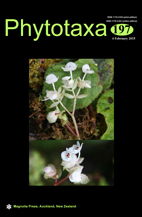Abstract
A total of 16 strains phylogenetically placed within the Nostocaceae were found to possess morphological features of the Rivulariaceae and Tolypothrichaceae (tapering trichomes and single false branching, respectively) in addition to their typical Nostocacean features (production of arthrospores in series). These strains formed a strongly supported clade separate from other strains that are phylogenetically and morphologically close. We describe four new species within the genus Roholtiella gen. nov. The four species include three distinguishable morphotypes. Roholtiella mojaviensis and R. edaphica are morphologically distinct from each other and from the other two species, R. fluviatilis and R. bashkiriorum. Roholtiella fluviatilis and R. bashkiriorum are cryptic species with respect to each other. All four species are easily distinguished based on the sequence of the 16S-23S ITS regions, in particular the flanking regions to the conserved Box-B and V3 helices. The species are further established by the elevated p-distance between species that is much reduced among strains within the same species. Calochaete cimrmanii, a recently described tapering species from tropical biomes, is the most likely sister taxon to Roholtiella.

